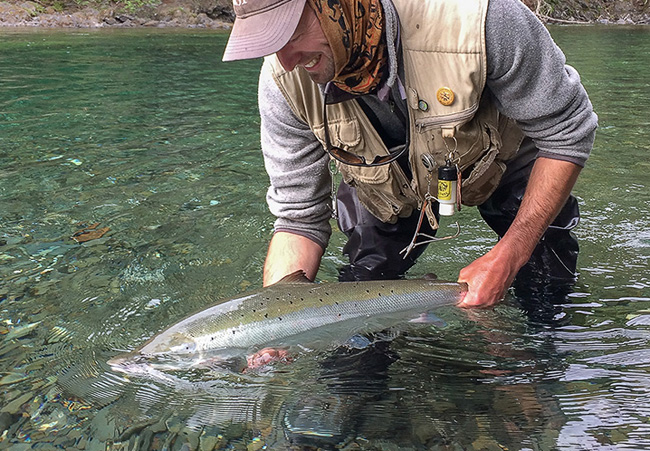
ASF’s Nathan Wilbur prepares to release a salmon on the Bonaventure River this year. Note his pliers, bare hands, and the careful handling of the fish. ASF image.
Atlantic Salmon Federation Rivernotes / July 12, 2018
[dropcap]A[/dropcap]nglers are a force for conservation, and every time one of us handles a wild Atlantic salmon we have a responsibility to practice impeccable live release techniques. There is a right way and a wrong way to do it. Here are some important reminders:
1. Don’t land the fish in shallow water or on the rocks: This is a brutal way to land a fish and it WILL be fatal almost 100% of the time and within an hour time.
2. Keep the fish IN the water: Salmon exert a great deal of energy on the end of an anglers line. Once the fish is landed, give it a chance to quickly recover by keeping the head and gills in the water.
3. Reduce the time you play the salmon: Atlantic salmon have a three-chambered heart that is less efficient than yours. Quickly land the fish to reduce its physical exertion.
4. Don’t use nylon nets or landing gloves: These remove the sensitive coating of the fish and damage scales, weakening a fish and possibly leading to infection. Bare hands and rubber nets are best.
5. Carry forceps or needle-nose pliers: Smoothly remove the barbless hook while keeping the fish in the water as much as possible.
6. Support the salmon in the water: Don’t pull the salmon back and forth in the current, instead hold the fish nose facing upstream and gently support its weight as it recovers. The fish will let you know when it is ready to swim away. Don’t be afraid to get your shirt wet in order to better hold the salmon. It is the least you can do.
Watch this video. It’s well worth your time. It was produced by ASF, FQSA, and the Quebec Government. There is nothing like seeing it being done right . . .
[youtube id=”8ztoZGBoxwg” width=”620″ height=”360″]


